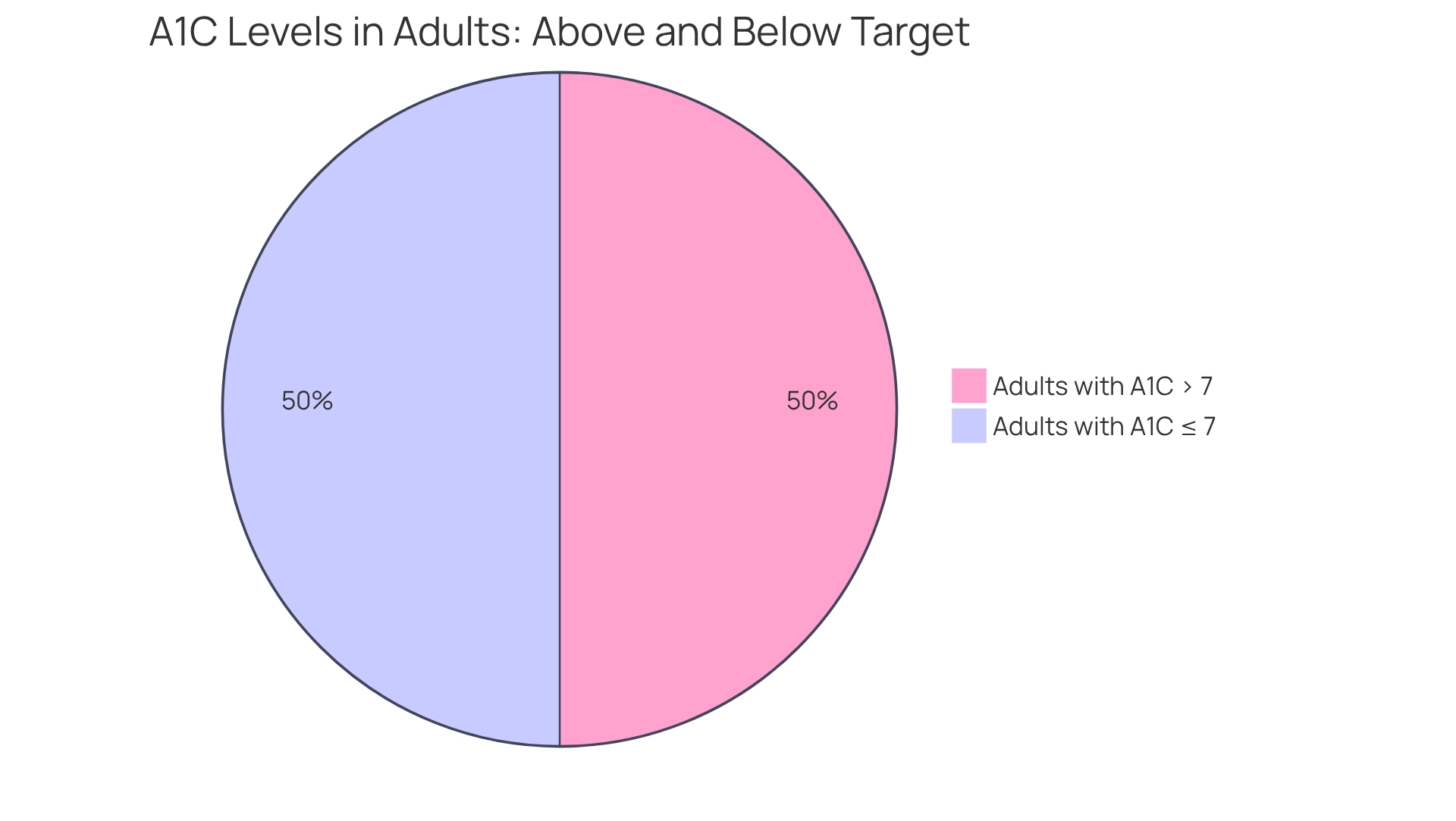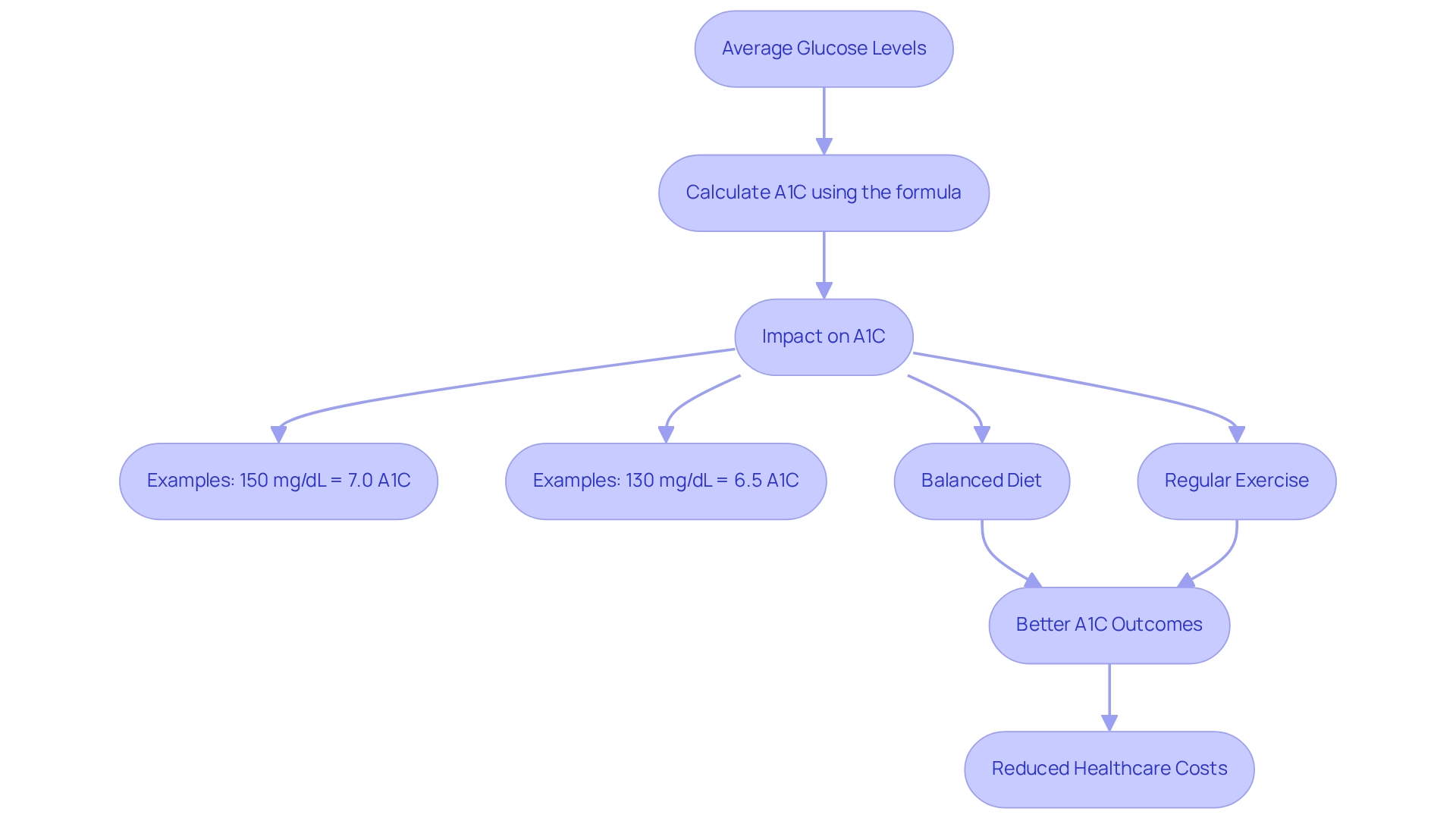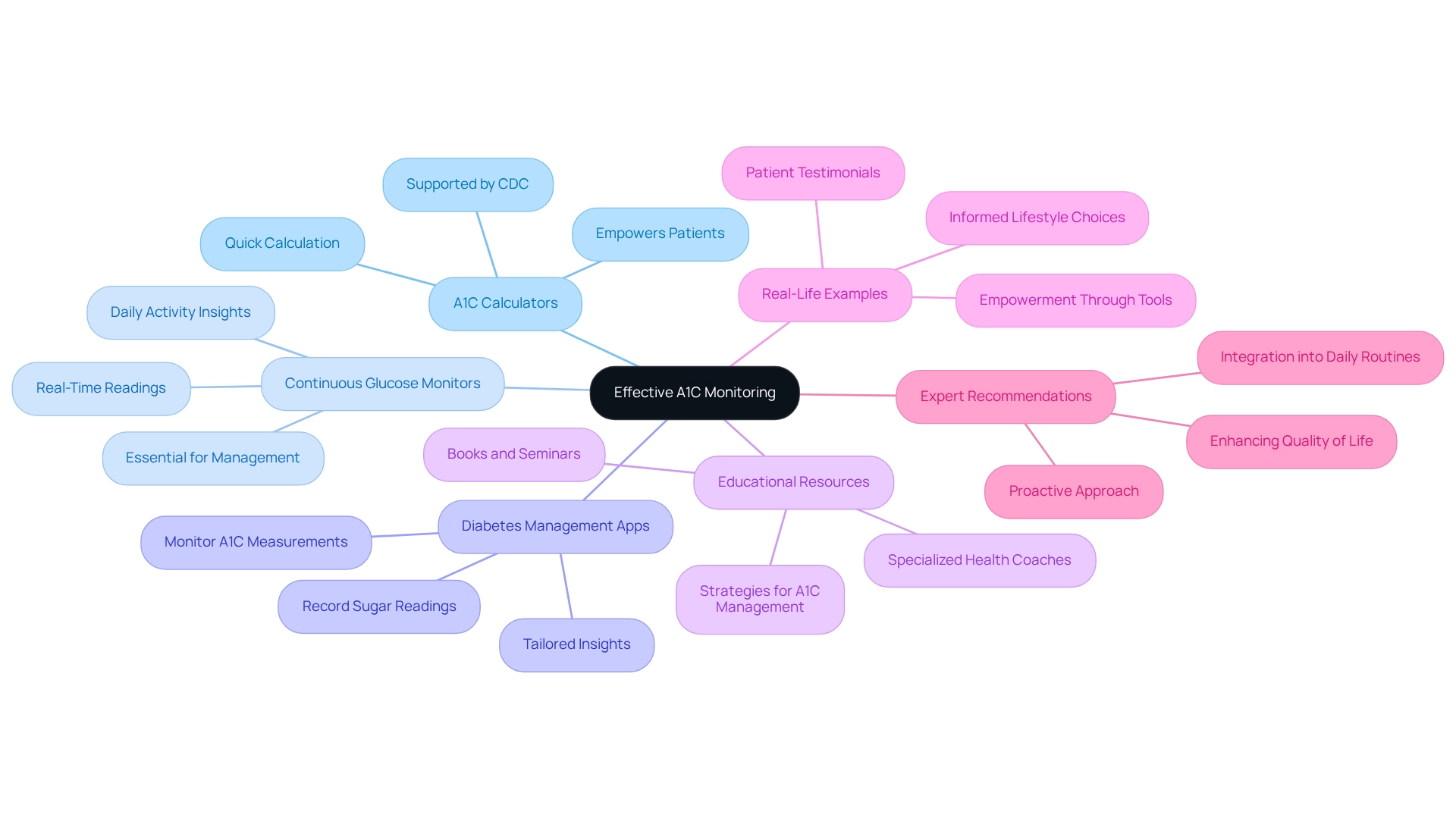Overview
This article addresses a crucial aspect of diabetes management: calculating A1C from average glucose levels. Many individuals struggle with understanding how these numbers relate to their health, and it’s important to recognize that this knowledge can empower you in your journey. By using a clear formula for this calculation, we can help you see how maintaining an A1C below 7% can significantly reduce the risk of complications. Real-world examples and expert recommendations illustrate how effective monitoring tools can support you in achieving this goal.
Imagine how reassuring it would be to know that by keeping your A1C in check, you are taking significant steps toward a healthier future. It’s not just about numbers; it’s about your well-being and peace of mind. Many patients find that establishing a routine with these calculations can foster a sense of control and confidence in their health journey.
As you read through this article, consider how these insights might apply to your daily life. The path to managing diabetes can feel overwhelming at times, but you are not alone. We encourage you to take action toward healthier living, such as exploring the 30-Day Diabetes Reset program, which offers supportive guidance tailored to your needs. Remember, every small step counts, and you have the power to make meaningful changes.
Introduction
In the realm of diabetes management, it’s important to recognize the significance of A1C levels. This critical blood test not only reflects average blood sugar levels over several months but also serves as a vital indicator of your health trajectory. Many individuals with diabetes find it challenging to maintain optimal A1C levels, with alarming statistics revealing that nearly half of adults struggle in this area. The urgency for effective management strategies has never been clearer.
By exploring the intricate relationship between A1C and average glucose levels, you can gain valuable insights into your health. This knowledge empowers you to take control of your diabetes. This article delves into the importance of A1C monitoring, offers practical steps for calculation, and highlights essential tools and resources to enhance your diabetes care. Together, we can pave the way for a healthier future.
Understand A1C and Its Importance in Diabetes Management
A1C, or hemoglobin A1C, is a vital blood test used to calculate A1C from average glucose levels over the past two to three months, expressed as a percentage. For those facing type 2 blood sugar challenges, it’s generally recommended to maintain an A1C measurement below 7% to help reduce the risk of serious complications, such as heart disease, kidney damage, and neuropathy. It’s concerning that recent statistics indicate around 50% of adults with high blood sugar have an A1C measurement exceeding this target, underscoring the need for effective management strategies.
Understanding how to calculate A1C from average glucose readings is crucial for both patients and healthcare providers, as this method serves as an important indicator of how well a blood sugar management plan is working. Regular monitoring enables timely adjustments to treatment, which can significantly enhance health outcomes. Research has shown that elevated A1C readings are associated with a higher risk of diabetes-related complications, emphasizing the importance of proactive management.
Real-world experiences highlight the impact of A1C on diabetes outcomes. Many patients who successfully lower their A1C values often report feeling more energetic and experiencing an overall sense of well-being. In contrast, those with consistently high readings may confront debilitating complications that can severely affect their quality of life. For example, one patient shared, “I was on 2 different meds that weren’t working and was told that I needed insulin. After joining the program, I lost 55 lbs. My A1C started at 9.1, and after 8 months, it is now 5.7.” This showcases the transformative effects of personalized care and holistic health solutions offered at Integrative Wellness Center.
Experts agree that maintaining ideal A1C levels is essential for long-term health. Many advocate for tailored strategies to achieve these goals. Case studies from the center demonstrate the effectiveness of holistic health solutions in managing A1C values. By addressing the root causes of diabetes and providing personalized education, patients have seen significant improvements that help them calculate A1C from average glucose readings, leading to a better quality of life and reduced dependence on medications. As Dr. Jason Shumard emphasizes, “By providing patients with actionable insights and practical tools, the center fosters an environment where individuals can reclaim their health and well-being.” Furthermore, given the concerning statistics regarding hospital safety, understanding and managing A1C values remains a cornerstone of effective care.
Explore the Connection Between Average Glucose and A1C Levels
Understanding the connection between average sugar concentrations and how to calculate A1C from average glucose can feel overwhelming, but it’s crucial for effective diabetes management. The formula A1C (%) = (Average Sugar (mg/dL) + 46.7) / 28.7 demonstrates how to calculate A1C from average glucose, showing that even a small change in A1C corresponds to a significant shift in average sugar levels—about 28 mg/dL for each 1% rise. Recognizing this correlation empowers individuals to see how their daily sugar readings directly impact their A1C outcomes, helping them set realistic goals for better blood sugar control and learn how to calculate A1C from average glucose, as in the case of a patient with an average sugar reading of 150 mg/dL, who would likely have an A1C around 7.0%. On the other hand, maintaining an average blood sugar level of 130 mg/dL could lower the A1C to approximately 6.5%. These examples highlight the importance of regularly monitoring and managing daily sugar levels to calculate A1C from average glucose in order to achieve desired A1C targets.
Incorporating a holistic approach to lifestyle changes can significantly enhance diabetes management. It’s important to recognize that a balanced diet filled with fresh, local produce, along with regular outdoor exercise in the beautiful parks of San Marcos, can provide essential support. Many patients find that engaging in community wellness programs and practicing mindfulness techniques like yoga further aids in blood sugar control. Recent studies indicate a positive correlation between improved A1C results and reduced overall healthcare costs. The American Diabetes Association notes that data from various studies show that better A1C outcomes lead to lower total healthcare expenses.
The A1C test has been a cornerstone in managing blood sugar levels for nearly 40 years, offering a broader perspective on sugar control. Meanwhile, daily blood sugar monitoring gives a more detailed view of fluctuations. This dual strategy is vital for comprehensive management, allowing patients to calculate A1C from average glucose levels, ultimately leading to better health outcomes. Additionally, addressing barriers to diabetes care access is crucial. Effective self-management requires the right tools and knowledge, which platforms like Welldoc strive to provide. Together, we can navigate this journey toward better health and well-being.
Calculate A1C from Average Glucose: Step-by-Step Instructions
To calculate your A1C from your average glucose, follow these steps:
- Obtain Your Average Blood Sugar Level: This value can be derived from your daily blood sugar readings over a month. For example, if your average blood sugar is 150 mg/dL, you can use this value to calculate A1C from average glucose.
- Use the formula to calculate A1C from average glucose: A1C (%) = (Average Blood Sugar (mg/dL) + 46.7) / 28.7.
- To calculate A1C from average glucose, perform the calculation: for an average sugar level of 150 mg/dL, the calculation would be: (150 + 46.7) / 28.7 = 6.87%. Thus, you can calculate A1C from average glucose, and your estimated A1C is approximately 6.9%.
- Interpret Your Result: To assess the effectiveness of your condition management, you can calculate A1C from average glucose and compare it with the recommended targets.
It’s important to recognize that in 2025, average blood sugar readings for individuals with type 2 condition typically range around 140-160 mg/dL. This makes regular monitoring essential. Many patients find that getting an A1C test at least two times a year helps ensure effective management of their condition. Ongoing blood sugar monitoring systems can deliver real-time information, capturing daily variations and providing a more complete perspective of your sugar readings. As Dr. Jason Shumard observes, “Continuous sugar monitoring can capture daily variability of blood sugar levels and provide real-time information on how different factors affect sugar levels, offering a more comprehensive picture when combined with A1C.”
To enhance your diabetes management, consider implementing SMART goals—specific, measurable, attainable, relevant, and time-bound. For instance, you might aim to lower your average blood sugar by a certain percentage over the next month. Consistently monitoring your progress not only encourages responsibility but also enables the adjustment of your objectives in response to shifting fitness standards. Practical instances emphasize the significance of this computation; patients at Dr. Shumard’s facility who actively participate in tracking their average sugar report notable enhancements in their A1C figures, frequently conveying appreciation for the empowerment they experience in overseeing their health. By following these steps and establishing organized objectives, you can take charge of your management and work towards achieving your health aspirations.
Utilize Tools and Resources for Effective A1C Monitoring
To effectively monitor your A1C and average glucose levels, it’s essential to consider utilizing some helpful tools and resources that can make a real difference in your journey toward better health.
- A1C Calculators: Have you ever felt overwhelmed by understanding your A1C levels? Online calculators, like those from the American Diabetes Association, can quickly calculate A1C from average glucose. A study involving 182 matched controls, supported by the CDC, shows that these calculators significantly aid in managing blood sugar levels. Many patients report a clearer understanding of their health metrics, which can be empowering.
- Continuous Glucose Monitors (CGMs): Imagine having real-time sugar readings at your fingertips. CGMs enable users to observe how daily activities influence their blood sugar values. The usage of CGMs among individuals experiencing blood sugar issues has increased, with many finding them essential for effective management.
- Diabetes Management Apps: Apps such as mySugr and Glucose Buddy can be your companions in this journey. They allow you to record sugar readings, monitor A1C measurements, and receive tailored insights. These tools not only enhance patient engagement but also support adherence to management plans, making the process feel more manageable.
- Educational Resources: Seeking knowledge is a powerful step. Books and seminars led by health coaches specializing in blood sugar regulation, including Dr. Jason Shumard‘s comprehensive guide on reversing type 2 conditions, provide crucial information on effective management and the significance of A1C monitoring. Attend our next event to receive Dr. Shumard’s book for free, which includes specific strategies for A1C monitoring and management.
- Real-Life Examples: You’re not alone in this journey. Numerous patients have successfully utilized A1C calculators and CGMs to calculate A1C from average glucose, which has led to more informed lifestyle choices and improved health outcomes. Testimonials highlight the empowerment felt by individuals who actively engage with these tools. As Dr. Jason Shumard states, “By providing patients with actionable insights and practical tools, the center fosters an environment where individuals can reclaim their health and well-being.”
- Expert Recommendations: It’s important to recognize that healthcare professionals advocate for integrating these tools into daily routines. They emphasize their role in fostering a proactive approach to diabetes management. By leveraging these resources, you can reclaim your health and enhance your quality of life. Remember, every step you take is a step toward a healthier you.
Conclusion
Understanding and managing A1C levels is crucial for effective diabetes care. It’s important to recognize that A1C reflects long-term blood sugar control and has significant implications for overall health. Many patients may feel overwhelmed, especially with nearly half of adults with diabetes struggling to maintain optimal A1C levels. This highlights the necessity for proactive management strategies.
Many find that the connection between average glucose levels and A1C underscores the importance of consistent monitoring and lifestyle adjustments. By recognizing how daily glucose readings influence A1C results, individuals can set realistic goals and implement holistic strategies that promote better health outcomes. The step-by-step approach to calculating A1C from average glucose serves as a practical tool for patients to actively engage in their management journey.
Utilizing available tools and resources, such as A1C calculators, continuous glucose monitors, and diabetes management apps, can empower individuals to take charge of their diabetes. These resources not only facilitate a better understanding but also foster a proactive approach to achieving desired health outcomes. Have you considered how these tools might fit into your daily routine?
Ultimately, by prioritizing A1C monitoring and management, individuals with diabetes can significantly improve their quality of life, reduce the risk of complications, and pave the way for a healthier future. The journey towards effective diabetes management starts with informed choices and a commitment to understanding one’s health metrics. Remember, every small step counts, and you are not alone on this journey.
Frequently Asked Questions
What is A1C and why is it important?
A1C, or hemoglobin A1C, is a blood test that measures average glucose levels over the past two to three months, expressed as a percentage. It is important for managing blood sugar levels and reducing the risk of complications related to diabetes, such as heart disease and kidney damage.
What is the recommended A1C target for individuals with type 2 diabetes?
For individuals facing type 2 diabetes challenges, it is generally recommended to maintain an A1C measurement below 7% to help minimize the risk of serious complications.
What percentage of adults with high blood sugar have an A1C measurement exceeding the recommended target?
Recent statistics indicate that around 50% of adults with high blood sugar have an A1C measurement exceeding the recommended target of 7%.
How can A1C be calculated from average glucose readings?
Understanding how to calculate A1C from average glucose readings is crucial for both patients and healthcare providers, as it serves as an important indicator of the effectiveness of a blood sugar management plan.
What are the benefits of regular A1C monitoring?
Regular monitoring of A1C enables timely adjustments to treatment, which can significantly improve health outcomes and reduce the risk of diabetes-related complications.
What impact does lowering A1C levels have on patients?
Many patients who successfully lower their A1C values report feeling more energetic and experiencing an overall sense of well-being, while those with consistently high readings may face debilitating complications that negatively affect their quality of life.
What holistic strategies are recommended for managing A1C levels?
Experts advocate for tailored strategies that address the root causes of diabetes, providing personalized education and actionable insights to help patients manage their A1C levels effectively.
How does the Integrative Wellness Center help patients with A1C management?
The Integrative Wellness Center offers personalized care and holistic health solutions that have shown effectiveness in managing A1C values, leading to significant improvements in patients’ health and reduced dependence on medications.



